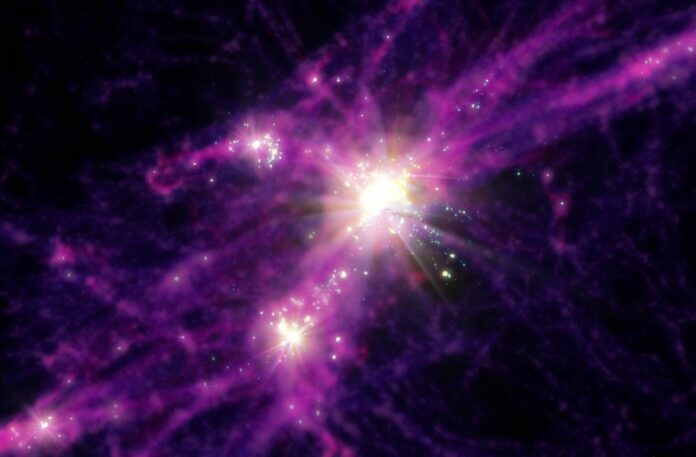From Big Bang to Bright Burst: The Starbursting Secrets of Ancient Galaxies Revealed
When researchers first examined the initial images from the James Webb Space Telescope (JWST) showcasing the universe’s most ancient galaxies, they were taken aback. These nascent galaxies seemed unusually luminous, vast, and advanced, considering they emerged shortly after the Big Bang. This was akin to a toddler transitioning into adulthood in a mere few years.
Such a revelation led a few physicists to reconsider the prevailing cosmological framework, pondering its possible overhaul.
However, thanks to innovative simulations, a group of astrophysicists guided by Northwestern University has unearthed that these galaxies might not be as colossal as initially thought. While galaxy luminosity is commonly linked to its mass, recent insights indicate that even less massive galaxies can radiate intense light due to sporadic, dazzling episodes of star birth.
This understanding not only clarifies the illusion of these galaxies seeming immense but also aligns seamlessly with the current cosmological blueprint.
This study was published today in the Astrophysical Journal Letters.
“The discovery of these galaxies was a big surprise,” comments senior author André Faucher-Giguère, “because they were substantially brighter than anticipated.
Usually, a galaxy’s brightness corresponds to its size. However, given that these galaxies took shape during the cosmic dawn, there hasn’t been sufficient time since the Big Bang.
How Did Early Galaxies Shine So Brightly?
“Our simulations show that galaxies have no problem forming this brightness by cosmic dawn.”
“The key is to reproduce a sufficient amount of light in a system within a short amount of time,” explains lead author Guochao Sun.
“That can happen either because the system is really massive or because it has the ability to produce a lot of light quickly. In the latter case, a system doesn’t need to be that massive. If star formation happens in bursts, it will emit flashes of light. That is why we see several very bright galaxies.”
The cosmic dawn, spanning from about 100 million to 1 billion years post-Big Bang, witnessed the birth of the universe’s initial stars and galaxies. Before the launch of JWST, this ancient era remained largely enigmatic to astronomers.
Sun points out, “The JWST brought us a lot of knowledge about cosmic dawn. Prior to JWST, most of our knowledge about the early universe was speculation based on data from very few sources. With the huge increase in observing power, we can see physical details about the galaxies and use that solid observational evidence to study the physics to understand what’s happening.”
In their recent research, Sun, Faucher-Giguère, and their colleagues utilized sophisticated computational simulations to recreate the galaxy formations soon after the Big Bang. Remarkably, their simulated galaxies during the cosmic dawn mirrored the luminosity of those detected by the JWST.
These simulations are a segment of the Feedback of Relativistic Environments (FIRE) initiative, co-initiated by Faucher-Giguère with partners from institutions like the California Institute of Technology, Princeton University, and the University of California at San Diego. Additionally, the study included contributions from the Flatiron Institute’s Center for Computational Astrophysics, Massachusetts Institute of Technology, and the University of California, Davis.
The FIRE models integrate advanced algorithms with astrophysical concepts to depict the genesis of galaxies.
These simulations allow scientists to investigate the processes of galaxy birth, development, and morphological transitions, all while accounting for the contributions of energy, mass, momentum, and chemical compositions from stars.
Executing these models, Sun and colleagues found an intriguing pattern of “bursty star formation” during the cosmic dawn. Unlike vast galaxies such as the Milky Way, where star formation is consistent and incrementally rising, this “bursty” mode reveals a cyclical pattern: a sudden surge in star creation, followed by extended intervals with minimal stellar activity, and then another surge.
“Bursty star formation,” according to Faucher-Giguère, “is especially common in low-mass galaxies.”
The specifics behind this phenomenon remain under active investigation. According to the author, a cluster of stars emerges, and after a few million years, these stars detonate as supernovae. This explosion propels the gas out, which subsequently gets drawn back in to give rise to new stars, perpetuating the star formation cycle. However, in significantly larger galaxies with more potent gravitational forces, the supernovae’s explosions can’t dispel the gas. This gravitational strength maintains the galaxy’s cohesion, stabilizing it over time.
The simulations successfully mirrored the profusion of luminous galaxies that the JWST detected. This means that the predicted count of radiant galaxies from the simulations aligns with what was actually observed.
While many astrophysicists speculated that sporadic star creation might explain the unique luminosity of galaxies during the cosmic dawn, it’s the Northwestern team that first validated this idea through intricate computer models. Notably, they achieved this without introducing elements that deviate from our accepted universe framework.
As Faucher-Giguère pointed out, “Most of the light in a galaxy comes from the most massive stars. Because more massive stars burn at a higher speed, they are shorter lived. They rapidly use up their fuel in nuclear reactions. So, the brightness of a galaxy is more directly related to how many stars it has formed in the last few million years than the mass of the galaxy as a whole.”
Image Credit: Aaron M. Geller, Northwestern, CIERA + IT-RCDS
